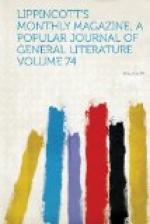a group of modern artists who set to work to illuminate
a sacred text, and that in which the task was undertaken
by cloistered monks in whose gray lives a longing for
beauty, for color, found expression only here.
Thus one realizes that the decorative borders—which
one looks at over and over again in this volume, and
which actually satisfy the eye—do not represent
the artist’s own actual dreams, but are founded
instead upon the ecstatic visions of Fra Angelico
and others as they bent over their work in their silent
cells; but they are beautiful nevertheless, far transcend
what is merely decorative, and are full of imagination
and feeling. In fact, into this frame-work, which
might have contained nothing beyond conventional imitation,
Mr. Smith has put vivid touches which show that he
has the faculty to conceive and the skill to handle
which belong to the true artist. It would be
easy to instance several of these borders as remarkably
good in their way: that which surrounds the “Lord’s
Prayer” suggests dazzling effects in jewelled
glass. The book is made up in a delightful way,
with full-page pictures interspersed with vignettes
illustrating the text and set round with those richly-designed
borders to which we have alluded. Mr. Fenn’s
pictures of actual places in the Holy Land, besides
striking the key-note of veracity which puts us in
a mood to see the whole story under fresh lights,
are full of beauty and charm. We are inclined
to like everything in the book, although in the various
ways in which the beatitudes are interpreted we are
conscious of some incongruities, and wish that certain
illustrations had made way for designs showing more
unity of conception among the artists. For instance,
Mr. Church’s introduction of a New England scene
of tomahawking Indians cannot be said to throw a flood
of light upon the meaning of “Blessed are they
that are persecuted for righteousness’ sake.”
Mr. St. John Harper’s pictures are a trifle obscure;
but their obscurity veils their want of pertinence
and suggests subtilties that flatter the imagination
into fitting the application to suit itself. Any
mention of the book which failed to include Mr. Copeland’s
work on the engrossed text would be altogether inadequate,
for it is very perfect, very beautiful, full of surprises
and delightful quaintnesses, and helps to make the
book what it actually is, a complete whole, which really
answers our wishes of what an illustrated book should
be.
Mr. Whittier’s “Poems of Nature” make the felicitous occasion this year for one of Messrs. Houghton & Mifflin’s rich and attractive series of their authors’ selected works. An admirable etching of the poet faces the title-page, and the poems, chiefly descriptive of New England scenes, are illustrated by designs from nature, the work of a single artist. That Mr. Kingsley is in sympathy with the poet, and that he is an impassioned lover of nature and the various moods of nature, no one can doubt, and the impression of truthfulness




